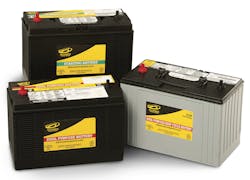[what's new in:] Batteries
This is an era of change in terms of battery and charging systems, says Gale Kimbrough, engineering & technical services manager at Interstate Batteries. “One of the challenges we’re seeing as an industry is that commonly used Group 31 absorbed glass mat (AGM) batteries are not lasting as long as expected. This is often due to using the wrong type of AGM battery for the application’s needs,” he says. “A combination of using the correct AGM batteries along with an effectively designed charging system will yield the best solution.”
There are three primary types of AGM batteries: one for starting, another for deep cycling, and a third to accomplish both. Unlike flooded lead acid batteries, explains Kimbrough, an AGM battery is a lead acid battery in which the liquid electrolyte is suspended and absorbed within the material that separates the negative and positive plates. Within the AGM category, there are alloyed and pure lead designs, the latter of which can provide an advantage for meeting repeated deep cycle charging requirements caused by parasitic loads. In effect, a pure lead AGM battery can offer deep cycles and tens of thousands of starting cycles.
“With proper specs, truck batteries will have both the correct cranking ability and the reserve capacity needed to cycle and keep up with loads, such as those caused by battery-powered, engine-off HVAC systems,” says Brad Bisaillon, director of strategic accounts—North America & Europe at Trojan Battery. “It’s not just the number of times a battery is used but also the total amount of energy that is cycled through the battery. Repeated discharging and recharging cycles stress the integrity of the battery’s active materials and can cause a loss of overall capacity, and the deeper the discharge the more rapid this capacity loss can be.”
In effect, the design features of a battery for engine starting are the exact same features that can make a battery the wrong choice for use with electric-powered devices. The energy used in starting an engine discharges the battery by only about 1% of its total available capacity, Bisaillon explains, while a battery-powered device can discharge the battery by 80% or more of its available capacity.
Temperature also impacts battery life. While warmer temperatures help increase battery capacity for starting, points out Maria Orlando-Krick, marketing manager at EnerSys, maker of Odyssey brand batteries, they also cause an increase in the rate at which the battery charges and discharges. “Shorter amounts of time between recharges causes sulfation, a by-product of the reaction between the battery’s lead plates and sulfate in the electrolyte, to accumulate inside the battery,” she explains. “As a result, sulfation prevents a normal recharge from occurring and eventually leads to battery failure.”
The need for the correct battery is increasingly important when temperatures begin to drop. Cold temperatures can limit the speed at which a battery takes a charge. In very cold weather before the battery warms up, the truck’s alternator can sometimes power the vehicle, masking the fact that the battery isn’t accepting a normal charge.
Battery drain is another issue for fleets, especially at parking facilities where drivers require hotel loads for comfort and convenience items during long rest periods required by new hours-of-service regulations. To help prevent starting issues caused by battery drain, notes Ryan Bennett, vice president-product and marketing at Idle Smart, the company recently added a battery protect feature to its automatic engine start-stop solution. The system continuously monitors voltage levels and will start and run a vehicle’s engine to recharge batteries. He adds that fleets can customize voltage thresholds and recharge run-times with the feature.
Fleets can avoid breakdowns, downtime and the high cost of a service call by using the correct battery for operational needs. Tracey Meyer, product marketing manager-Aftermarket, Daimler Trucks North America, the provider of the Alliance Truck Parts brand of truck batteries, says fleets should look for starting and dual-purpose batteries that are optimized to help deliver efficient starting power and provide protection from deep cycle damage, improving performance in all types of applications.
For more information, visit these websites:
Alliance Truck Parts
www.alliancetruckparts.com
Exide Technologies
www.exide.com
Idle Smart
www.idlesmart.com
Interstate Batteries
www.interstatebatteries.com
Odyssey Battery (EnerSys)
www.odysseybattery.com
Trojan Battery
www.trojanbattery.com
TRP
www.trpparts.com
